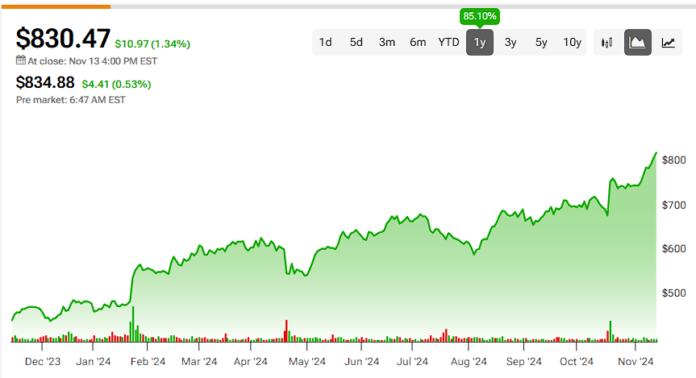Netflix Stock Soars: Future Growth Looks Promising
Netflix (NFLX) has seen its stock surge over 85% in the past year, yet analysts suggest that future gains may be within reach. This streaming leader is not only expanding its membership base but also its revenue, even amidst fierce competition. With free cash flow expected to grow significantly in the upcoming years, there are solid reasons to remain optimistic about NFLX stock.

Strong Revenue Growth
Netflix’s impressive growth largely stems from a steady increase in its global subscriber count. In its recent Q3 report, the company announced a 14.4% rise in paid memberships, accompanied by a 15% jump in revenue compared to the previous year. These numbers reflect an acceleration from Q3 2023, when the company recorded 10.8% membership growth and 7.8% revenue growth.
This achievement is notable given the crowded streaming market, with competitors like Disney’s (DIS) Disney+ and Amazon’s (AMZN) Prime Video vying for audiences. Netflix attributes its positive results to several hit shows, including The Perfect Couple and Monsters: The Lyle and Erik Menendez Story, which bolstered viewer engagement. Moreover, Netflix’s advertising sector is gaining traction, as evidenced by a 35% increase in ad-supported plan memberships from the previous quarter, making up over half of new sign-ups in those markets.
Promising Future Growth
The outlook for Q4 further supports the notion of Netflix’s ongoing growth. The company’s management anticipates another quarter of double-digit revenue growth, indicating that the momentum may continue. Upcoming content, including highly anticipated releases like “Squid Game S2” and NFL games on Christmas Day, is expected to attract more subscribers and enhance viewer engagement. Along with price adjustments in some markets, Netflix projects a 14.7% revenue increase in Q4, closely matching the Q3 growth rate.
Expanding Free Cash Flow
A key factor driving confidence in Netflix is its rapidly growing free cash flow. As the company scales, it has managed to stabilize capital expenditures (CAPEX), leading to a significant boost in free cash flow – from $1.9 billion last year to $2.2 billion in Q3. Analysts predict free cash flow will reach $6.59 billion in 2024.
Looking beyond, projections suggest $8.99 billion in free cash flow by 2025 and $10.75 billion in 2026. This trend illustrates how Netflix can efficiently utilize its growing subscriber base without a corresponding rise in costs. Consequently, the potential for further acceleration in free cash flow generation makes a compelling case for the stock’s upward trajectory.
As previously mentioned, despite a relatively high valuation—with the stock currently trading at 53 times this year’s expected free cash flow—investors may find reassurance in its growth plans. By 2026, the valuation may appear more favorable at approximately 44 times projected free cash flow, indicating the company’s capability to justify its valuation through continued growth.
Is NFLX Stock Worth Buying?
Wall Street opinions on Netflix are more cautious, with the stock receiving a Moderate Buy rating. Over the past three months, 24 analysts recommend a buy, 10 a hold, and two a sell. The average price target stands at $786.86, suggesting a potential downside of 5.25% from its current price.

For those considering trading NFLX stock, Jason Helfstein from Oppenheimer (OPY) is a notable analyst to follow. He has an impressive track record, boasting a 48.3% average return per rating and a flawless 100% success rate over the past year.
Read more analyst ratings on NFLX stock
In Summary
Netflix has demonstrated exceptional growth in both its membership and revenue, despite facing a mature market and increased competition. Its strong content offerings and expanding advertising initiatives create a robust foundation for future growth. Paired with increasing free cash flow, Netflix is well-positioned to continue leveraging economies of scale, making its current valuation attractive for long-term investors.
Disclosure
The views and opinions expressed herein are the views and opinions of the author and do not necessarily reflect those of Nasdaq, Inc.

